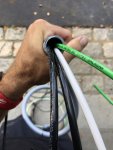I started my electrical learning journey in pools where the main way of powering everything is through non metallic flexible pvc conduit or non metallic rigid pvc conduit with THHN wires. I was planning on wiring a subpanel where I need to pull 6 gauge THHN wires and am seeing a bunch of different charts on maxiumum number of wire gauge in conduit.
Does this apply to wires pulled separate in a conduit as I’ve always done?
Does this apply to wires pulled separate in a conduit as I’ve always done?


